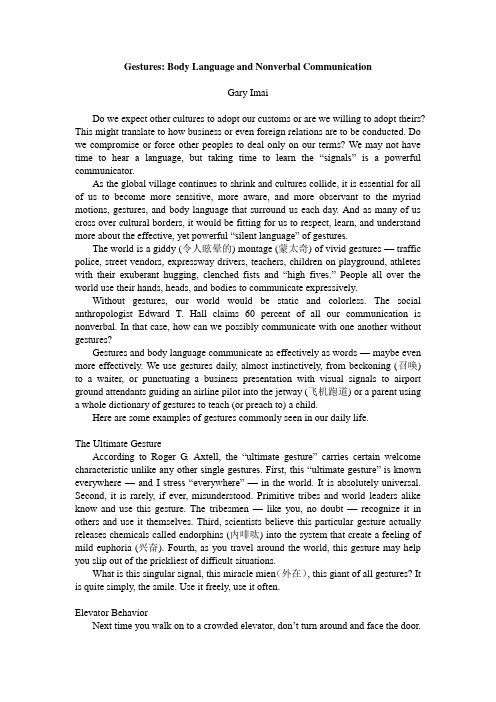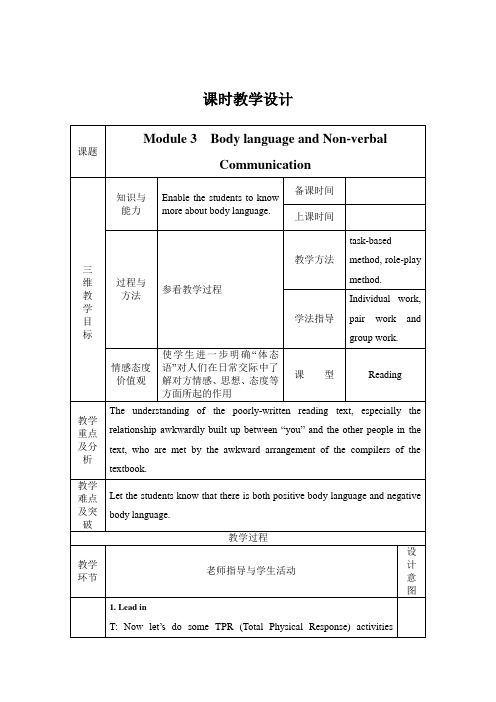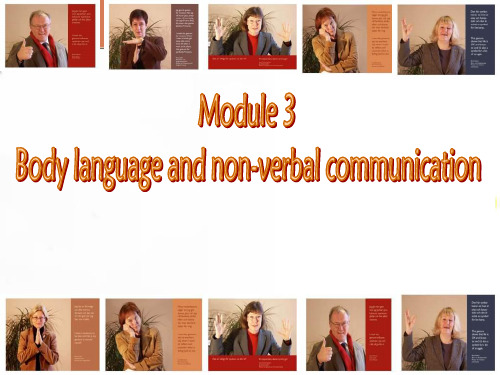导入阅读Body_Language_and_Non-verbal_Communication
- 格式:ppt
- 大小:7.28 MB
- 文档页数:40

外研版必修四Module 3 Body Language and Non-verbalCommunication 全单元教案课时计划课时1课题Module 3 Body language and non-verbal communication Listening& vocabulary课型New教学目标1. Enable the students to learn how to talk about body language and non-verbial communication.2. Enable the students to learn the different pronunciations between British and American English.重点Enable the students to learn how to talk about body language and non-verbial communication.难点Enable the students to learn how to talk about body language and non-verbial communication.学情分析The Ss can finish the task.教具课件1. A recorder2. A projector3. A computer教法Explanation---guidance---do the exx again教学程序教学内容(引入、例题、练习题、检测题等)师生活动时间分配Step 1Step 2Revision1 Proof readingPractice(1) Only in this way ___________ progress in your English. (MET84) (B)A. you makeB. can you makeC. you be able to makeD. will youable to make(2) He is the only one of the students who ___ a winner of scholarship for threeyears. (沪2002春招) (D)A. isB. areC. have beenD. has been(3) Only then ___________ the importance of health. 只有那时我才认识到健康的重要性。

Gestures: Body Language and Nonverbal CommunicationGary ImaiDo we expect other cultures to adopt our customs or are we willing to adopt theirs? This might translate to how business or even foreign relations are to be conducted. Do we compromise or force other peoples to deal only on our terms? We may not have time to hear a language, but taking time to learn the “signals” is a powerful communicator.As the global village continues to shrink and cultures collide, it is essential for all of us to become more sensitive, more aware, and more observant to the myriad motions, gestures, and body language that surround us each day. And as many of us cross over cultural borders, it would be fitting for us to respect, learn, and understand more about the effectiv e, yet powerful “silent language” of gestures.The world is a giddy (令人眩晕的) montage (蒙太奇) of vivid gestures — traffic police, street vendors, expressway drivers, teachers, children on playground, athletes with their exuberant hugging, clenched fists and “high fives.” People all over the world use their hands, heads, and bodies to communicate expressively.Without gestures, our world would be static and colorless. The social anthropologist Edward T. Hall claims 60 percent of all our communication is nonverbal. In that case, how can we possibly communicate with one another without gestures?Gestures and body language communicate as effectively as words — maybe even more effectively. We use gestures daily, almost instinctively, from beckoning (召唤) to a waiter, or punctuating a business presentation with visual signals to airport ground attendants guiding an airline pilot into the jetway (飞机跑道) or a parent using a whole dictionary of gestures to teach (or preach to) a child.Here are some examples of gestures commonly seen in our daily life.The Ultimate GestureAccording to Roger G. Axtell, the “ultimate gesture” carries certain welcome characteristic unlike any other single gestures. First, this “ultimate gesture” is known everywhere —and I stress “everywhere” — in the world. It is absolutely universal. Second, it is rarely, if ever, misunderstood. Primitive tribes and world leaders alike know and use this gesture. The tribesmen —like you, no doubt —recognize it in others and use it themselves. Third, scientists believe this particular gesture actually releases chemicals called endorphins (内啡呔) into the system that create a feeling of mild euphoria (兴奋). Fourth, as you travel around the world, this gesture may help you slip out of the prickliest of difficult situations.What is this singular signal, this miracle mien(外在), this giant of all gestures? It is quite simply, the smile. Use it freely, use it often.Elevator BehaviorNext time you walk on to a crowded elevator, don’t turn around and face the door.Instead, just stand there face the others. If you want to create even more tension, grin. Very likely the other passengers will glare back, surprised, grim, and upset. They respond in this way simply because you have broken the rules.This demonstrates how, even in the most mundane (平凡的) situations, we have a silent set of rules for bodily behavior in public settings.When X people enter an elevator, they each ...Gestures are woven inextricably in to our social lives, but also that the “vocabulary” of gestures, can be at once informative and entertaining ... but also dangerous. Gestures can be menacing (two drivers on a freeway), warm (an open-armed welcome), instructive (a police man giving road directions), or even sensuous (the liquid movement of a Hawaiian hula dancer).In the world of gestures, the best single piece of advice is to remember the two A’s —“Ask” and be “A ware.” If you see a motion or gesture that is new or confusing, ask a local person what it signifies. Then, be aware of the many body signs and customs around you.(Retrieved Sep. 16, 2008, from /~tassi/ gestures.htm, with modifications)。

高中英语必修四《Body Language》教案设计一、教学目标1.知识目标:o学生能够掌握并识别至少10种常见的肢体语言信号及其含义。
o学生能够理解不同文化背景下肢体语言的差异和共性。
o学生能够运用所学词汇和句型描述和分析肢体语言在不同情境中的应用。
2.能力目标:o提高学生的跨文化交际能力,使其能在国际交流中准确解读他人肢体语言。
o培养学生的观察力和分析能力,通过观察视频或实际场景中的肢体语言,推断交流者的情绪和意图。
o增强学生的口语表达能力,使其能用英语流畅地讨论肢体语言的相关话题。
3.情感态度价值观目标:o培养学生尊重多元文化,理解并接纳不同文化中的肢体语言习惯。
o激发学生对非言语交流的兴趣,认识到肢体语言在日常沟通中的重要性。
o鼓励学生积极参与课堂互动,培养合作学习的精神。
二、教学内容-重点内容:肢体语言的基本概念、常见肢体语言信号及其含义、文化差异对肢体语言的影响。
-难点内容:如何在具体情境中准确识别并解读复杂的肢体语言信号,以及如何在跨文化交流中有效运用肢体语言。
三、教学方法-讲授法:介绍肢体语言的基本概念和理论知识。
-讨论法:分组讨论不同文化背景下肢体语言的差异,分享个人经验。
-案例分析法:通过观看视频片段,分析具体情境中的肢体语言。
-多媒体教学:利用、视频和音频资源,丰富教学内容,提高学生的学习兴趣。
四、教学资源-教材:《高中英语必修四》-教具:多媒体投影仪、电脑-多媒体资源:肢体语言相关视频、课件、音频材料-实验器材:无五、教学过程六、课堂管理1.小组讨论:每组分配明确的任务,确保每位学生都有参与机会。
设定时间限制,避免讨论偏离主题。
2.维持课堂纪律:通过设定课堂规则,如举手发言、尊重他人意见等,维持良好的课堂秩序。
3.激励学生:对积极参与课堂活动和表现突出的学生给予表扬,激发学生的积极性和参与热情。
七、评价与反馈1.课堂小测验:通过选择题或填空题的形式,测试学生对肢体语言基本知识的掌握情况。

课时教学设计课题Module 3 Body language and Non-verbalCommunication三维教学目标知识与能力Enable the students to knowmore about body language.备课时间上课时间过程与方法参看教学过程教学方法task-basedmethod, role-playmethod.学法指导Individual work,pair work andgroup work.情感态度价值观使学生进一步明确“体态语”对人们在日常交际中了解对方情感、思想、态度等方面所起的作用课型Reading教学重点及分析The understanding of the poorly-written reading text, especially the relationship awkwardly built up between “you” and the other people in the text, who are met by the awkward arrangement of the compilers of the textbook.教学难点及突破Let the students know that there is both positive body language and negative body language.教学过程教学环节老师指导与学生活动设计意图1. Lead inT: Now let’s do some TPR (Total Physical Response) activitiestogether, I hope you will enjoy them and have fun as well.T: Ok. It’s time to take up the lesson. Please look at the screen. Let’s take a look at the following gestures:Gesture Action MeaningA handshake You are welcome.A clap of hand Come on; be cheerful.A V-shape of the fore-finger and middle finger May you succeed!Or congratulations on your success!Ahalf-closed hand with thumb down I am not in favor of your idea or I’ll have to refuse you.Awrinklingof the browin thoughtordispleasureShe is worried.or a scowlTearscoming outof his eyes.He is very sad.All smiles on her face She is very happy.Waving their hands They are waving goodbye to people around.A hand stretched out forward with strength He is stopping a tank.People jump with their both hands stretched open in the air. They are cheering for the victory.2 Pre-reading1. What is the function of body language?2. How do you find body language in our daily life?3. How can the same body language express different feelings or ideas in different cultures?3 Fast readingTURE OF FALSE4 Further readingT: We have just read a passage entitled “Showing Our Feelings”, which tells us more about body language. Now let’s read another passage in the Workbook on P66. The title of the reading text is: The Open Hand - A Universal Sign. You will be given 3 minutes to read through the text as quickly as you can, trying to get as much information from the text as possible.T: Before we come to the end of this period, let’s take up the last item, doing the arrangement of the information under the passage on Page 67.S8: It can be dangerous to meet people you do not know.S9: Many Asian people do not usually physically touch strangers.S10: If we show an open hand, it means that we are not holding anything dangerous.S11: The right hand is usually used because it is almost the stronger. S12: People shake their hands when meeting to show that they can be trusted.S13: To show respect, people will touch their heart and mouth when greeting someone.作业Homework1. Read aloud all the reading texts in this unit.2. Get ready to retell the two reading passages learnt in this period.课后反思。

Body Language and Non-verbalCommunicationBook4module3BodyLanguageandNon-verbalcommunication LearningPaper4ExerciseⅠ.Bestchoice.---$500,butthatismylastoffer.---ok,it’sa______.A.costB.pricec.dealD.reward2.Herfacegaveher____whenshetoldalie.A.offB.upc.awayD.out3.Shestilllovedhim___hehadtreatedhersobadly.A.howeverB.eventhoughc.whateverD.however4.whenhewasinNewyork,hemethisgoodfriendjim______.A.byaccidentB.bymistakec.bythewayD.bythetime5.Heis____agoodfathertome;heisalsomybestfriend.A.notB.onlyc.morethanD.really6.Herbrother_____toleaveherinthedarkroomalonewhensh edisobeyedhisorder.A.declaredB.threatenedc.warnedD.frightened7.Heisamanoffewwords;besides,itishardto____hismind.A.readB.seec.makeitclearD.lookat8.---won’tyougoshoppingwithyourmother?---____shepromisestobuymeanewsweater.A.NowthatB.Incasec.IfD.Unless9._____otherssay,theprofessorissurethathistheoryisc orrect.A.NomatterhowB.whatc.whateverD.How0.Paper-makingbeganinchinaandfromhereit_____toNorth AmericaandEurope.A.spreadB.grewc.carriedD.developed1.Hetriedhisbesttosolvetheproblem,_____difficultitw as.A.howeverB.nomatterc.whateverD.although2.____shewastired,____shewentonworking.A.Though;butB.when;andc.Though;/D.Because;/3.Theweather____tohourinsomemountaindistricts.A.varyfromanhourB.variesfromhourc.isdifferentfromanhourD.differfromanhour4.Istaredblankly___thepaperinfrontofme.A.inB.atc.downD.out5.Visitors____nottotouchtheexhibits.A.willrequestB.requestc.arerequestingD.arerequestedⅡ.Filltheblankswithproperprepositions..Ifeltsadwhenshesaidgoodbye____me.2.whateverheis,heshouldn’tberude____me.3.Thesoldier____guarddidn’tletmeentertheroom.4.InsomeAsiancountries,youmustn’tsitwithyourfeetpointing____anotherperson.5.Heisamanhardtodeal_____.6.Inthatcountry,youmustn’ttouchsomeoneonthehead,even____accident.7.Ifyoukeepstaring_____thatlady,youwillmakeheruncomfo rtable.8.Idon’twanttobeinvolved____thatproblem.Ⅲ.completethefollowingsentenceswiththewordsgiven,u singproperformswhennecessary.1.youcan’t____abarofsteeleasilywithoutatool.2.whilewatchingtheperformance,thechildrencheeredand _____theirhands.3.Hemadesome_____toexpresswhathewanted.4.weshouldavoid_____atpeoplebecauseitisbadmanners.5.Thewomanfelthisson’s______andfoundthathehadafever.Ⅳ.Translation..如果他12点前不来,我们就不等他了。

Book IV Module 3 Body Language and Non-verbalCommunication2课中学习目标:To use some key words and phrases concerned correctly.To grasp the grammar: adverbial clause of condition and concessionTo know how to communicate with people using body languageTo know about the culture in communication and enlarge their eyesight.学法指导:自主、合作、探究式I. leading-in: Check previewing job.II. Presenting Task: Write a short passage about body language according to the given materialsIII. language pointsPart I Introduction1. 与某人握手_2. 与某人沟通交流 Communication (n.) 交流; 通讯1.) 父母发现有时候很难与他们那十几岁的孩子交流。
Parents sometimes find .2.) 与东部的一切交通均因地震而中断。
__________ with the east .PartⅡ Reading and Vocabulary1. 入乡随俗2. Although these are very important, we communicate with more than just spoken andwritten words.3. vary vi 改变, 变化在…方面不同伴随某种因素而变化1.) 学生的作业质量参差不齐。
Module 3 Body Language and Non-verbal Communication词类转换:1 communication n. _______________ vi.2 unconscious adj. _______________( oppo )3 vary v. ___________n. ____________ adj4 aggressive adj. _____________n.5 religion n. _________________ adj6 panic v. ______________(过去式) ______________(过去分词)7 invitation n. ______________ v.8 performance n. ___________ v.9 judgement n. _______________ v.10 social adj. ____________ adv . _________ n11 equality n. __________adj . ____________adv.12 formal adj. __________(oppo)13 threaten v. __________n. __________adj.14 applaud v. __________n.一、佳句再现1. Indeed body positions are part of ____________ “body language”.的确,身体姿势是我们称之为“身体语言”的一部分。
2.…yet there is also “learned body language”,_________________________________.……然而也有一些“有意识的”身势语言,随着文化的不同而有所变化。
3.Muslims give a “salaam”,______they touch their heart, mouth and forehead. 穆斯林行额手鞠躬礼,用手触左胸、嘴和额。
Module 3 Body Language and Non-verbal Communication教学设计Explanations for new words and phrases导学P25-11、communicate:vt. /vi. (用语言,信号)传递信息(想法,感情,思想等);交流(信息,消息,意见等);沟通。
We only communicate by Email.只靠电邮进行交流。
A baby communicates its needs by crying.He was eager to communicate his ideas to the group. 他急于把想法传给小组。
communicate with sb. 与某人交流、联络。
We can communicate with the United States directly through the internet.用互联网,可直接与联合国联系。
Parents sometimes find it difficult to communicate with their teenage children.communicate sth. to sb. 告知某事给某人。
He communicated our secret to others. 把秘密告诉其他人。
He was eager to communicate his ideas to the group.communication:n. 交流/际,通讯U;通信工具CGood communication is important in a large organization.tele-communication 电信communication skills 通讯技能/思想交流技能be in communication with与...沟通/通讯;同...保持联系。